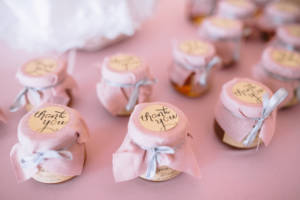
Wedding favors continue to be a popular way of saying thank you to wedding guests and bestowing them with a keepsake from the ceremony.
When you’re hosting a wedding, one of your goals is creating an enjoyable and meaningful experience. If you’re like many nearlyweds, you want to convey your appreciation for your guests’ willingness to celebrate with you. Many couples give wedding favors as unique mementos, but welcome bags have also gained popularity. If you’re not sure how to thank your invitees, read on for some guidance and ideas.
An Introduction to Wedding Favors
SBS TV’s Sarah Ward explains that wedding favors may have originated in Europe. Aristocrat families would give their party guests bombonieres, or lavish gift boxes filled with sugary treats. Eventually, the tradition became commonplace and the gift boxes were filled with sugared Jordan almonds.
Are wedding favors absolutely necessary for your event? It depends on who you ask. Wedding Wire Canada’s Alice Prendergast insists that you shouldn’t cut favors from your budget. Meanwhile, The Spruce’s Jessica Bishop argues that you should only include them if you have the time and budget along with ideas for a meaningful parting gift.
In Prendergast’s guide to wedding favors, she advises selecting inexpensive items and keeping total expenses to between 2% and 3% of your event budget. Couples should also let their wedding themes dictate the favors they choose. Children and adults can receive the same types of favors unless you plan on giving out alcoholic food or drinks.
How Favors Have Gotten an Upgrade
Traditional wedding favors include Jordan almonds or physical keepsakes such as bottle openers, wine or shot glasses, or coasters. Yet couples are now rethinking the concept, opting for items that aren’t just trinkets that take up space. Food is always a popular choice, especially since guests can snack on these delicious goodies while traveling back home. Weddingbells’ Baily Spagat showcases bite-sized edibles like chocolate candies, petit fours, and cake pops. For those seeking different choices, The Knot presents examples such as mugs filled with coffee beans, mini maple syrup bottles, and even warm cinnamon donuts passed out at the end of the reception.
In another piece for The Knot, Libby McCarthy stresses the importance of giving practical gifts. Avoid monogramming these items, since this will limit your attendees’ options for using them. Keep in mind that it’s perfectly fine to use monogrammed wrap or packaging. Candles, luggage tags, photo frames, and potted plants are excellent examples of non-edible items you can send home with your guests.
Welcome Bags and Other Alternatives
Some couples offer welcome bags instead of favors or provide both items to their guests. Brides writer Jenna Milliner-Waddell lists several essential staples to include in your welcome bags:
- Water bottles
- Sweet snacks
- Local maps and information
- Seasonal items such as hot drinks or sunscreen
- Your event itinerary
For destination weddings, Alice Prendergast suggests including thematic packaging along with locally sourced snacks and keepsakes. While you’re at it, don’t forget to slip in a sheet of emergency phone numbers. With a little imagination, you can adapt and apply these ideas to welcome bags for a locally hosted wedding.
Of course, you’re not limited to favors or welcome bags. The Knot’s Lauren Kay discusses experiential favors as an emerging trend in 2019. These are bonus events scheduled during your wedding weekend as an extra “thank you” to your friends and family. Kay mentions examples such as short boat cruises, hikes, or special classes, but many group activities can be turned into fun get-togethers.
Little Ways To Express Gratitude
Providing party favors for wedding guests has been a long-standing custom. Yet like any other tradition, people modify it to suit their preferences and values. Welcome bags are another wonderful option to make your friends and family feel appreciated. With a practical focus, these gifts are now more convenient and guest-friendly.


